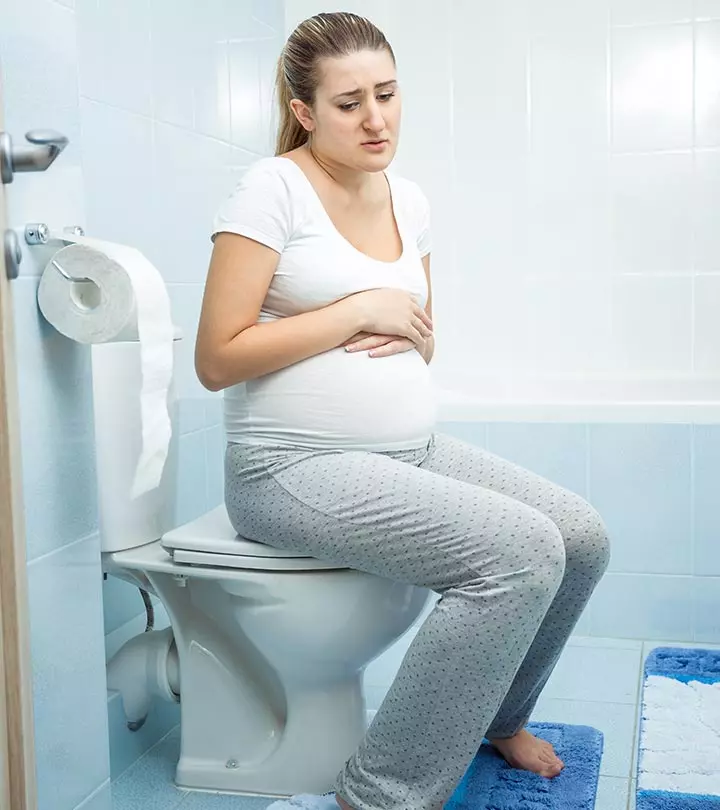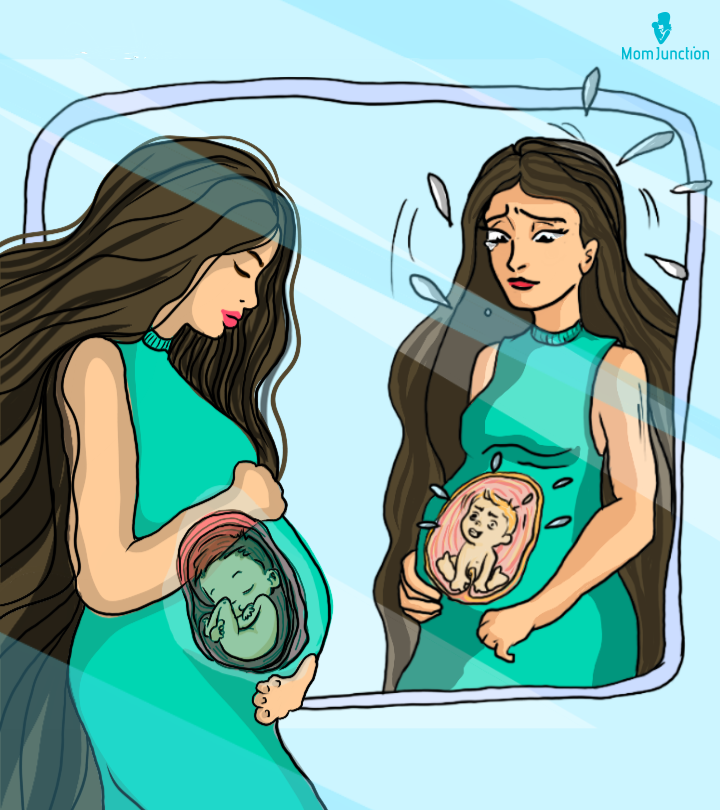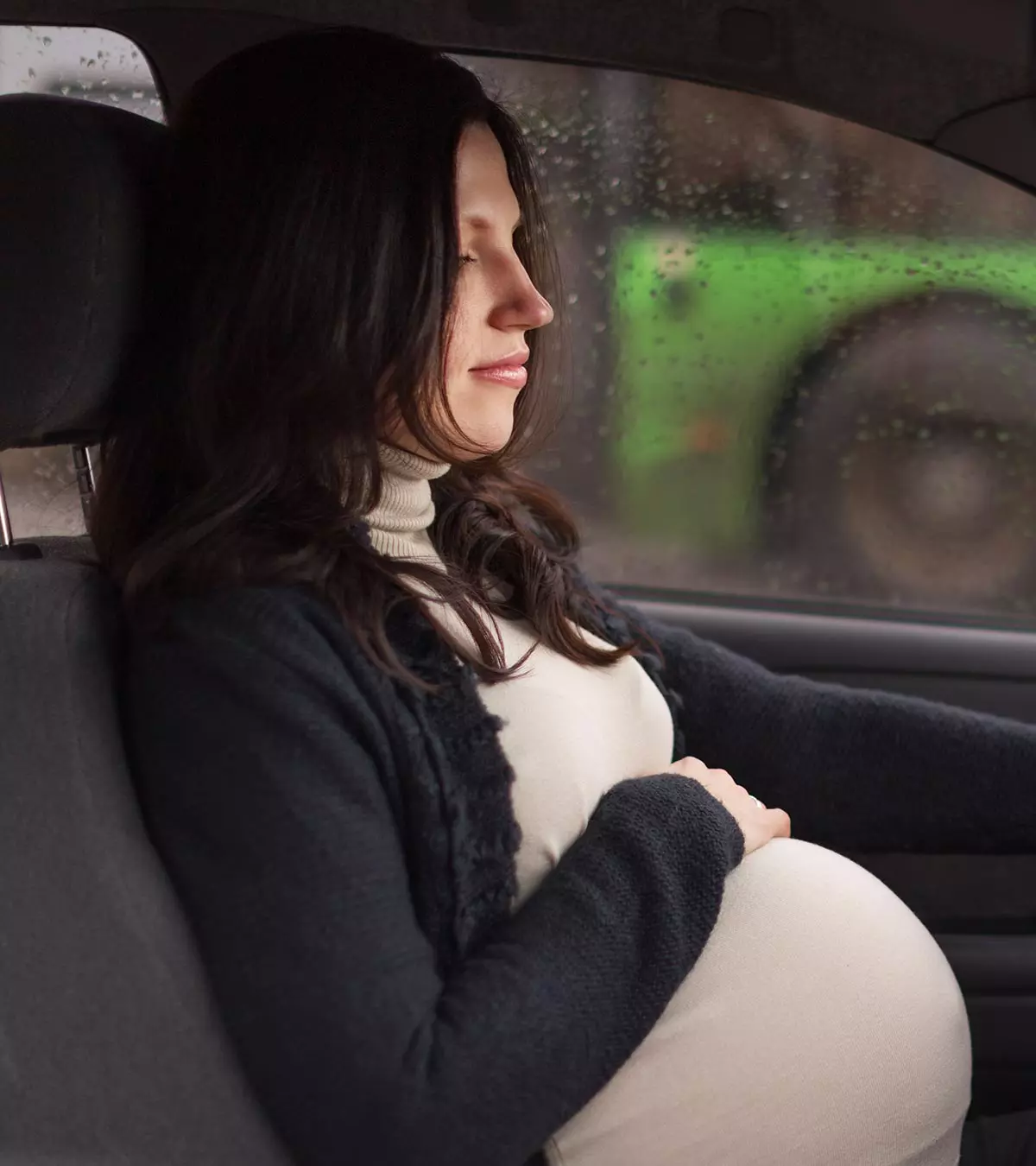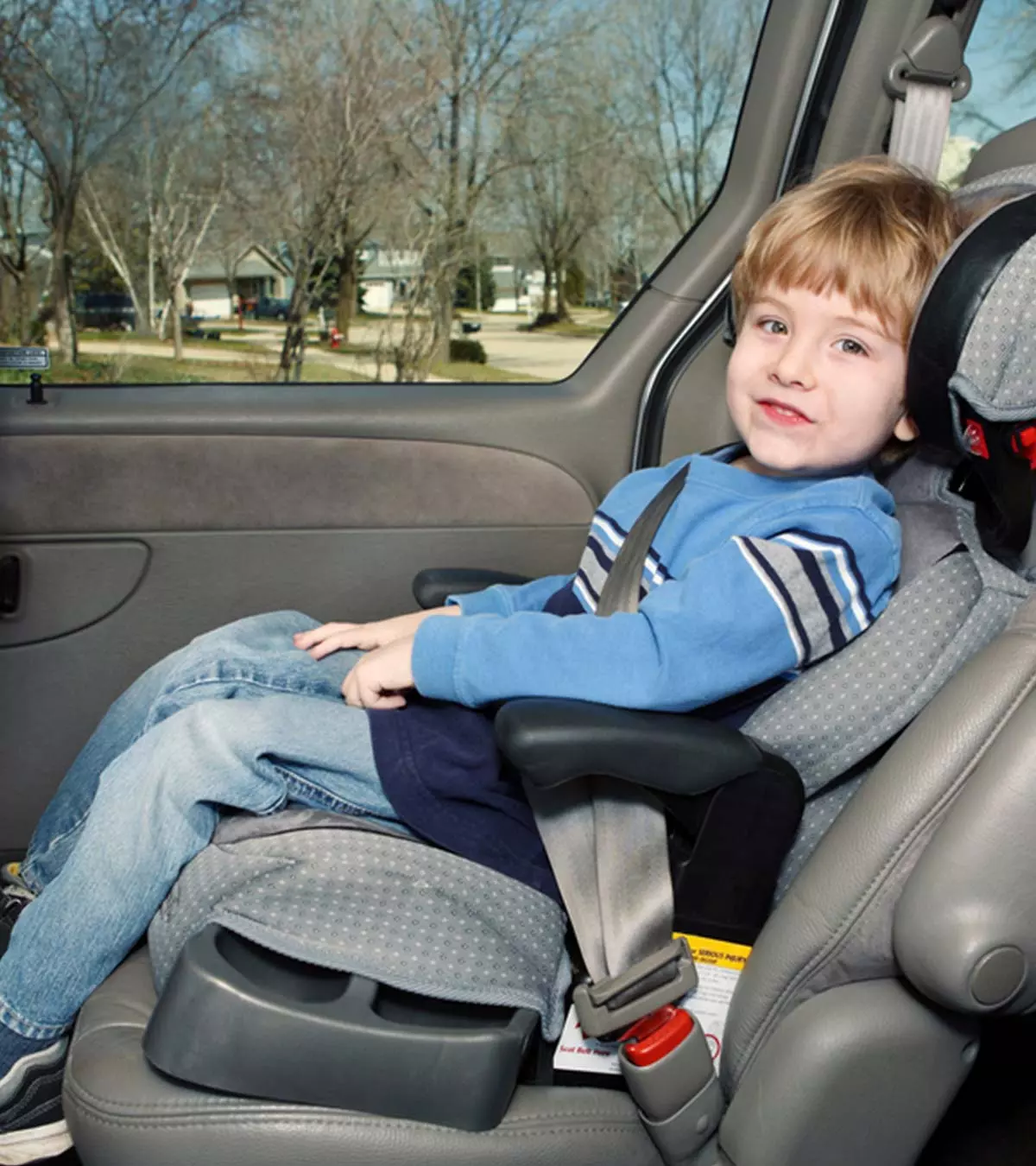
Image: Shutterstock
Booster seats help a child sit comfortably in the car once they outgrow their infant safety seat. Many parents may want to know when a child can stop using a booster seat since children may often demand sitting without booster seats. While it might be tempting to allow this transition early, you should prioritize safety. As per a report by the National Highway Traffic Safety Administration (NHTSA), car crashes remain a significant safety risk for children aged 1 to 13 (1). Further, the Centers for Disease Control and Prevention states that over 63,000 children who were not buckled up appropriately in their car seats were injured in car crash accidents in 2025 (2). Before you stop using a booster seat for your child, you should consider their size and age, specific safety guidelines, and more. Read on to learn more about when a child can stop using a booster seat and what factors you should consider before letting your child sit on a standard car seat.

Key Pointers
- A child can stop using a booster seat when the car’s seat belt fits properly without needing a booster seat.
- The height, position of belt, knee, feet, etc. could determine if the child can sit without a booster seat.
- A booster cushion is a booster seat without the backrest ideal for children who do not meet the requirements to sit in a car seat.
When Can A Child Stop Using A Booster Seat?
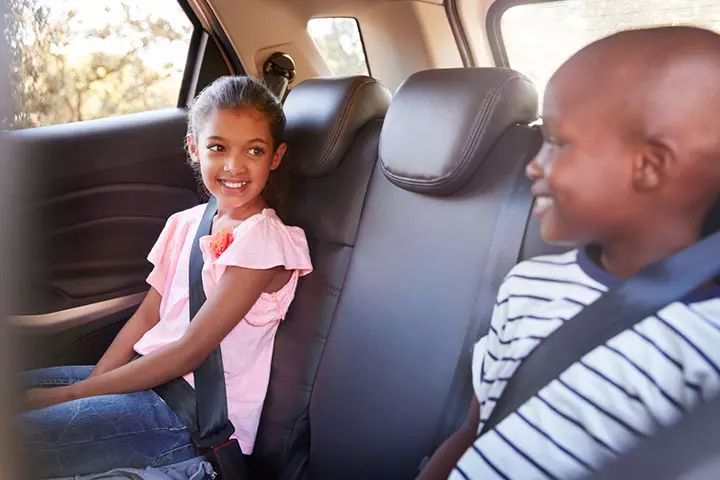
According to the US Centers for Disease Control and Prevention guidelines, a child can stop using a booster seat when the car’s seat belt fits properly without the need for a booster seat (3). A seat belt is considered an integral part of the occupant restraint system for protection. It fits properly when the lap belt goes across the upper thighs/the hips and not the stomach, while the shoulder belt goes across the chest and not the neck.
A child should begin using a booster seat once they outgrow their forward-facing car seat with a harness, typically when their shoulders are above the top set of strap slots. Many states in the United States have come up with booster seat laws. For instance, as per the Washington State regulations, a child must be around 4-6 years of age and weigh at least 40-60 pounds (4).
According to the American Academy of Pediatrics, a car’s seat belt can fit properly once the child attains the height of 4 feet and 9 inches (150 centimeters) and a weight of 80 pounds (5). Most children reach this height by the age of 13 and can sit without a booster seat.
We hope this information helps you answer the most common question ‘when can my child stop using a booster seat?’
 Point to consider
Point to considerHow To Know The Child Can Stop Using A Booster Seat?
Several factors beyond the child’s height could determine if they can sit without a booster seat (1) (7) (8).
1. Belt position
The car seat belt may not fit in some cases even if the child has attained the requisite height.
Therefore, check if your car’s seat belt fits your child correctly.
The shoulder belt must go over the child’s shoulder and the chest rather than the neck. A seat belt over the neck could be detrimental in a car crash. Also, a loose shoulder belt can slide over the child’s neck, thus negating its purpose.
The lap belt must go across the upper thighs or the hips. It should not lie over the belly where it may tug into the body in case of an accident.
2. Knee position
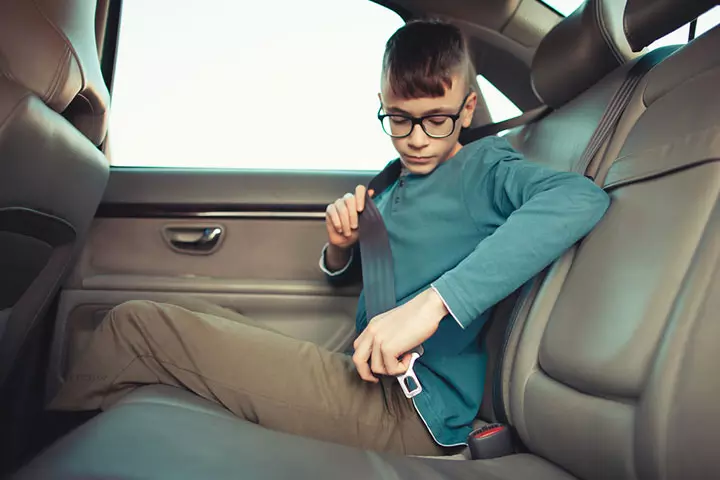
The child’s legs should comfortably bend over the seat’s edge with the knees placed in their natural position. If the child has to push the hip forward or slouch to let their knees come to the seat’s edge, then it is best to let them use a booster seat for some more time.
3. Feet position
The feet should lay comfortably flat on the car’s floor. If the child has to slouch, move forward, or strain their legs to lay the feet flat on the floor, they are not yet ready to move out of the booster seat.
4. Back position
The child’s back must be comfortably flush against the seat’s backrest. If the child slouches forward or there is a gap between the body and the backrest, your child is not ready to sit in the standard car seat. The correct back position against the backrest is vital to maintain the tension of the seat belt during a car crash.
 Quick tip
Quick tipA parent should check the child’s height and the above-mentioned factors before discarding the booster seat. Once your child is ready to move to the car seat, you can begin the process of transitioning.
How To Help A Child Transition To A Car Seat?
You may try the following steps to make it easier for a child to transition to a standard car seat.
- Practice in a stationary car: Before you take them for a long drive, let them have plenty of practice in a parked car. It is a good opportunity to educate the child about the importance of a seat belt and the correct way to buckle it. Encourage the child to do it themselves and find their comfortable position.

- Buy seat belt covers: It is a great way of making seat belts attractive to children. Take your child shopping for seat belt covers of their choice. You may pick seat belt covers that cushion the child during long drives.

- Make it a rite of passage to adulthood: Children are always keen on doing “grown-up things.” Make seat belt use an initial step into adulthood. Tell them how they are growing up and no longer can fit into booster seats meant for younger children.
What To Do If The Car Seat Belts Do Not Fit?
If the seat belts do not fit your child properly, it means your child is not yet ready to sit without a booster seat. Check other factors, such as the knee and back positions, to determine if the child is ready to sit in a standard car seat.
Some cars have height-adjustable seat belts. If your child meets all the requirements to sit without a booster seat but still faces issues with the seat belt, check the seat belt height. The seat belt height adjuster is located at the shoulder belt anchor on the car’s B-pillar (middle pillar). You may adjust the height until the seat belt goes across the child properly. A study investigating the relationship between demographic, anthropometric, and vehicle factors with seat belt fit in children aged 7–12 years highlights the variability in achieving a good seat belt fit. The report states, “Taller and older children have a better chance of achieving a good seat belt fit. However, with variations in seat geometry between vehicles, no single simple metric clearly defines an appropriate transition to the adult seat belt (9).” This finding emphasizes the importance of assessing the fit for each child and vehicle combination.
You may refer to your car’s manual for more details. Never buy after-market seat belt adjusters unless approved by the car manufacturer and regulatory authorities.
Should You Use A Booster Cushion?

A booster cushion is a booster seat without the backrest. It is ideal for children who do not meet the requirements to sit in a car seat. If your child needs a booster cushion to use a seat belt properly, they are not yet ready to stop using a booster seat (10).
 Point to consider
Point to considerFrequently Asked Questions
1. How do different booster seats affect when a child can stop using them?
Children can use infant-only rear-facing seats until the age of four or until they exceed forty pounds. After that, they need to use forward-facing or convertible seats until they outgrow them (11).
2. What are the dangers of allowing a child to stop using a booster seat too soon?
When a child transitions from a booster seat to a car seat too early, it can cause the child to be seated improperly in the vehicle, increasing the child’s risk of injury during braking or accidents (12).
3. What are the risks of a child not using a booster seat?
A child not using a booster seat can have a more severe impact in situations such as a car crash. Without the seat, the child may not be seated properly for the seatbelt to go below the hip bone, touching the thighs. Instead, it may be placed at their abdomen, leading to a spinal or internal organ injury during an accident (9).
Booster seats are comfortable for children after they cross the infant stage; these seats are crucial for ensuring your child’s safety. However, most parents have a common question – when can a child stop using a booster seat? According to experts, children may stop using booster seats only when they meet all criteria to use a seat belt correctly. Before transitioning to a car seat, check upon several vital factors, including the child’s height and body posture. Altogether, it is important to ensure the appropriate use of seat belts for the utmost safety of children.
Infographic: Seat Belt Safety Tips For Children
Ensuring car safety is paramount when traveling with a child. Here is an infographic with essential tips for using car seat belts correctly and a comparison between ISOFIX seats and seat belts.
Some thing wrong with infographic shortcode. please verify shortcode syntax
Illustration: When Can A Child Stop Using A Booster Seat In The Car?

Image: Stable Diffusion/MomJunction Design Team
Is your kid not fitting onto the booster seat anymore? This video outlines clear signs indicating when it’s time to transition, ensuring your child’s safety and comfort.
References:
- Car Seats and Booster Seats.
https://www.nhtsa.gov/vehicle-safety/car-seats-and-booster-seats - Risk Factors for Child Passengers.
https://www.cdc.gov/child-passenger-safety/risk-factors/?CDC_AAref_Val=https://www.cdc.gov/transportationsafety/child_passenger_safety/cps-factsheet.html - Child Passenger Safety.
https://www.cdc.gov/child-passenger-safety/about/?CDC_AAref_Val=https://www.cdc.gov/injury/features/child-passenger-safety/index.html - Is Your Child Ready for a Seat Belt?
https://depts.washington.edu/booster/pdf/manual/apprendixA.pdf - Booster Seats for School-Aged Children.
https://www.healthychildren.org/English/safety-prevention/on-the-go/Pages/Booster-Seats-for-School-Aged-Children.aspx - Car Seats: Information for Families.
https://www.healthychildren.org/English/safety-prevention/on-the-go/Pages/Car-Safety-Seats-Information-for-Families.aspx - Seat Belts.
https://www.nhtsa.gov/vehicle-safety/seat-belts - Booster Seat Safety Tips.
https://www.upstate.edu/gch/pdf/services/trauma/booster_seat_safety_tips.pdf - Anvay Parab et al.; (2025); Can Age or Height Define Appropriate Thresholds for Transition to Adult Seat Belts? An Analysis of Observed Seat Belt Fit in Children Aged 7–12 Years.
https://pmc.ncbi.nlm.nih.gov/articles/PMC8835682/ - Booster Cushions.
https://www.childcarseats.org.uk/types-of-seat/booster-cushions/ - Car Seat Safety.
https://kidshealth.org/en/parents/auto-baby-toddler.html - 5 Ways to Know Whether Your Child Should Still Be Using a Booster Seat.
https://www.consumerreports.org/booster-seats/how-long-should-your-child-be-using-a-booster-seat/#:~:text=Transitioning%20your%20child%20too%20early,work%20differently%20in%20each%20one. - Car Seat Safety: 4- to 8-year-old Children.
https://www.chop.edu/centers-programs/car-seat-safety-kids/car-seat-safety-by-age/4-8-year-old-children#:~:text=Belt%2Dpositioning%20booster%20seat,-When%20used%20correctly&text=If%20the%20vehicle%20seat%20belt,enough%2C%20he%20needs%20a%20boost.
Community Experiences
Join the conversation and become a part of our nurturing community! Share your stories, experiences, and insights to connect with fellow parents.
Read full bio of Dr. Pooja Parikh
Read full bio of Rohit Garoo
Read full bio of Dr. Ritika Shah
Read full bio of Shinta Liz Sunny









